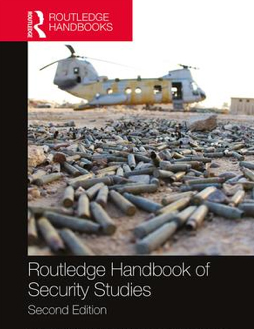Author: Edited by Myriam Dunn Cavelty and Thierry Balzacq
ISBN No: 9781138803930
Review date: 24/04/2024
No of pages: 480
Publisher: Routledge
Publisher URL:
https://www.routledge.com/Routledge-Handbook-of-Security-Studies/Cavelty-Balzacq/p/book/9781138803930
Year of publication: 25/08/2016
Brief:
Routledge Handbook of Security Studies, second edition, published 2016 by Routledge. Edited by Myriam Dunn Cavelty and Thierry Balzacq. Hardback, £150, 480 pages. ISBN 9781138803930. Visit https://www.routledge.com/.
Routledge Handbook of Security Studies, second edition, published 2016 by Routledge. Edited by Myriam Dunn Cavelty and Thierry Balzacq. Hardback, £150, 480 pages. ISBN 9781138803930. Visit https://www.routledge.com/.
By ’security studies’, the authors here mean security as a branch of international relations and politics. Hence a good quarter of the book, an update of the original 2009 edition, is given over to various regions, such as Israel, Syria and Russia. Some chapters are of more direct interest to the security manager, such as on crisis management, cyber-security, organised crime (by one of the UK authors in this multi-national work) and terrorism. It can be dry and theoretical rather than practical stuff; the chapter about organised crime for example takes you through the historical background and how various bodies in the field such as Europol think of organised (or serious) crime. As the author queries, for all the talk of methodology and threat assessment, do we know what drives serious crime, and how it’s actually organised – a gloomy thought, given that it’s been known about for several decades? Adam Edwards describes it as a ‘basic theory failure’.
As for terrorism, perhaps inevitably an academic field, ‘terrorism studies’ has sprung up and the chapter author Oldrich Bures, a Czech academic, says terrorism has been ‘clearly distinguished as a specific type of political violence’. As with organised crime, as terrorists are clandestine, there’s a lack of data. Also yet to be worked out, if indeed it’s possible to, is why someone commits violence, and why (or how) they become radicalised – all important questions with political and policing implications for countering terrorism. If security fails, so that people fear they will be a victim and change behaviour – won’t go to an open-air entertainment, for example, then the terrorist has won, even though as Bures points out that ‘statistically speaking it indeed may be enormously more likely that they will be killed in a traffic accident’.
And as for cyberspace, a Canadian scholar, Ronald Deibert points to how national governments are looking at doing cyber-security, to control against threats such as espionage, ‘typically involving greater responsibilities on the private sector to assist in policing their networks’. Here Edward Snowden crops up, for revealing that ‘US companies were legally compelled to turn over user data and install sophisticated data-mining equipment … all the while being legally compelled not to talk about it’. Deibert suggests that cyber-crime, espionage ‘and ever war’ are blurring, because for example a nation’s security service may hoard vulnerabilities in software that it can use – ‘back door’ in plainer English, in other words making more insecurity. Also, was the Stuxnet cyber-attack on Iran (by the US and Israel?) a case of ‘military action in cyberspace’? Deibert suggests that we could face a time of ‘potential chaos and instability, as cyber-crime continues its growth in an unabated fashion, an arms race in cyberspace escalates, served by a growing cyber-security industrial complex, and new, potentially lethal weapons are developed to target critical infrastructures’. Set against that, plenty of people want what the internet was set up to offer, such things as freedom of speech, access to information, and privacy.
This book may be of more relevance if your work is of the risk variety, and taking in such threats as pandemics and ‘energy insecurity’, that is, the likelihood of a country’s lights going out for lack of electricity supply.










